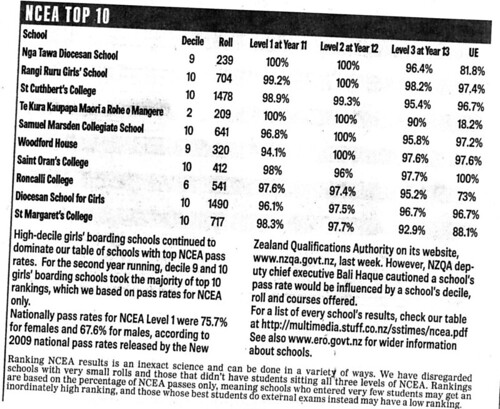
It interested me because it raises the question of what sort of schools are identified by the media as the 'top'.
A simple research exercise produces the following breakdown:
* Nga Tawa Diocesan School - Nga Tawa is a Year 9 -13 integrated, Anglican girls' boarding school - International Baccalaureate Diploma or NCEA
* Rangi Ruru Girls' School - Rangi Ruru Girls' School [is] an independent girls’ school - Rangi Ruru offers the NCEA.
* St Cuthbert’s College - is an independent Christian day and boarding school - The International Baccalaureate (IB) [and] NCEA
* Te Kura Kaupapa Maori o Mangere - a Kura Kaupapa Maori, a state school - unknown but certain to NCEA
* Samuel Marsden Collegiate School - is an independent girls’ school - All students work towards NCEA [and] Cambridge International Exam courses (CIE) are offered. Students may take up to three CIE subjects
* Woodford House - is an integrated school for boarding and day girls - Cambridge
* St Oran's College - is an integrated college for girls - NCEA
* Roncalli College - is an integrated coeducational Catholic school - NCEA
* Diocesan School - is a private Composite private School for Girls (Years 1-13) - International Baccalaureate Diploma or NCEA
* St Margaret's College - is an independent Anglican girls' college - NCEA or IB
In other words, 8 of the 10 are Girls schools. 4 are Integrated schools and 5 are 'independent' or private.
Only one, the Kura, is a State School.
All NZ schools are accredited to offer NCEA courses. But a number offer others, either as well as or instead of NCEA. So of the SST's Top 10, 4 offer the International Baccalaureate (IB) Diploma and 2 the Cambridge International Exam (CIE).
Of course, this narrow approach of looking only at the 'pass rates' at each level (& for University Entrance) is misleading. Because it completely ignores the performance of schools who, despite the odds, manage to achieve good outcomes for their students. In other words, there are many schools at which students achieve results which are ahead of expectations. There are a host of reasons why students face difficulties in achieving academic success - just start with home background.
A more meaningful measure therefore, might be to consider the 'value added' by schools. In other words, which is the more 'successful' school: one at which 100% of students will probably achieve Level 1 success and in fact do so; or one at which 30% of students will probably achieve Level 1 success but which achieves a 'pass rate' of 48%? Which school added the greatest value?
The difficulty with this concept is establishing how this can be measured! It is too complicated for mass media to contemplate, which is why they resort to simplistic measures such as that used by the SST. And by doing so, they perpetuate lazy thinking and a distortion of the value of the work done by our schools.
And now watch what happens with the new 'National Standards' in primary schools.
No comments:
Post a Comment